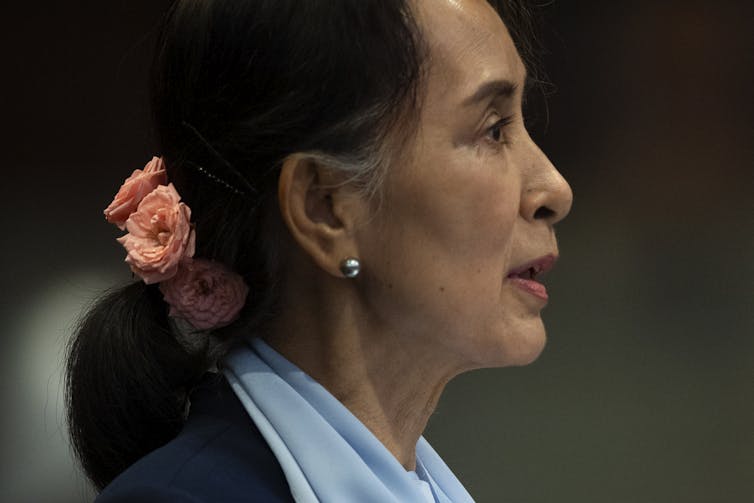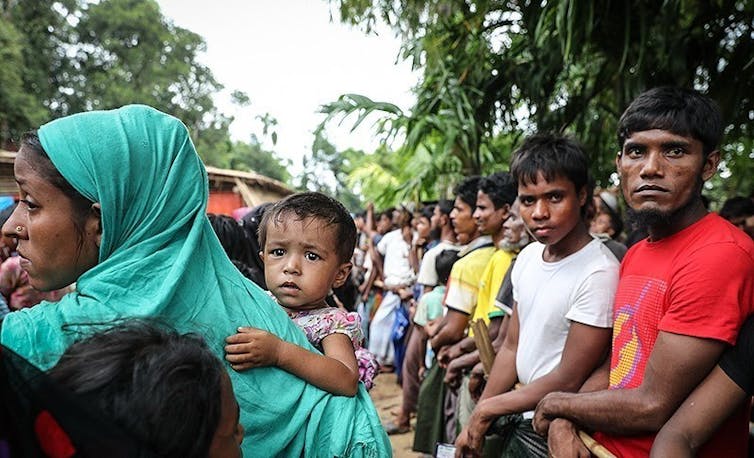Myanmar charged with genocide of Rohingya Muslims: 5 essential reads
Dozens of Muslim-majority countries are asking the UN's International Criminal Court to investigate and prosecute a 2017 massacre in Myanmar that killed an estimated 10,000 Rohingya Muslims.

Myanmar’s leader Aung San Suu Kyi is defending Myanmar in court against accusations of genocide.
According to a case brought by the country of Gambia at the United Nations’ International Court of Justice, the Myanmar military in August 2017 carried out a systematic, targeted campaign of terror, rape and murder against its Muslim population.
UN investigators say as many as 10,000 Rohingya – a Muslim minority in this Buddhist-majority nation – were killed. Another 730,000 Rohingya fled the massacre for Bangladesh, joining 300,000 Rohingya who had previously fled oppression in Myanmar.
Suu Kyi said during hearings at the Hague on Dec. 11 that the charge of genocide is “misleading” because “cycles of intercommunal violence” in Myanmar date “back to the 1940s.” The Myanmar military explains its campaign as a counter-terrorism effort against a violent Rohingya extremist group.
The Conversation has been following the Rohingya crisis closely. Here’s what you need to know about this persecuted Muslim group.
1. A British colonial legacy
The Rohingya story begins well before the 1940s, with the British colonization of Myanmar in the 1820s.
The British encouraged migrant laborers to come and work the rice fields of Myanmar, drawing many Rohingya into the country from neighboring areas. Census records show that between 1871 and 1911, the Buddhist country’s Muslim population tripled, according to Engy Abdelkader of Rutgers University.
In exchange for political support, the British promised to give the Rohingya their own Muslim territory within Myanmar, then called Burma. But Myanmar gained its independence in 1948, leaving the Rohingya to be ruled by a government they had not backed.
Myanmar officials didn’t just reject the Rohingyas’ request for an autonomous state, Abdelkader says. “Calling them foreigners, they also denied them citizenship,” she writes.
Within a few years, many Rohingya staged a rebellion against the new Myanmar government. It was brutally crushed, beginning a decadeslong cycle of repression that culminated, eventually, in the August 2017 massacre.
2. Fall from grace
Aung San Suu Kyi once seemed like a leader unlikely to defend gross human rights violations.

Before taking power in Myanmar in 2016, Suu Kyi was a Nobel Peace Prize winner. She had been imprisoned and then exiled, for fighting to bring human rights and democracy to this longtime military dictatorship. Her win in Myanmar’s first-ever democratic elections three years ago was celebrated worldwide.
Soon, however, Suu Kyi’s “international reputation would be in tatters,” write Anthony Ware and Costas Laoutides.
They cite Myanmar’s jailing of two Reuters reporters who in 2017 documented the atrocities committed against the Rohingya as the beginning of Suu Kyi’s fall from grace as a moral leader.
“It is notable that it was Suu Kyi’s civilian government that prosecuted the journalists, not the military,” they write.
Then came her apparent indifference to the suffering of the Rohingya. As reports of ethnic cleansing emerged, the world reacted with disbelief as Suu Kyi stayed silent.
3. Genocide is documented
In September 2018, the United Nations released a searing report detailing state violence against the Rohingya and demanding that Myanmar’s military leadership be held accountable for “genocide.”
The use of this blunt and powerful word was intentional, write Max Penksy and Nadia Rubaii, who study mass atrocities at Binghamton University.
“In the complex world of global diplomacy, using the term "genocide” to describe a state’s attacks on its own population is extremely rare,“ they write. "Genocide occurs when any number of violent acts are taken with the ‘intent to destroy, in whole or in part, a national, ethnical, racial or religious group.’”
Since the creation of the United Nations after World War II, few countries have been accused of genocide, among them Rwanda and the former Yugoslavia.
After the UN’s report drew global attention to the atrocities in her country, Suu Kyi publicly defended the military’s campaign against the Rohingya.
“With hindsight, we might think that the situation could have been handled better,” was her sole public expression of regret.
4. Life in limbo
As Suu Kyi tries to avert prosecution by the Hague, the nearly 1 million Rohingya refugees in Bangladesh live with danger and uncertainty.

Bangladesh has tried its best to manage the refugee crisis, says Cornell University professor Sabrina Karim, who visited refugee camps there in January 2018. The government established a new agency to coordinate international humanitarian aid and sent soldiers to guard sprawling new settlements in a previously uninhabited border area.
“But there are other issues that the government cannot completely control,” Karim writes.
That includes communicable diseases like the bacterial throat infection diphtheria, which has killed 45 Rohingya in Bangladesh since 2017, as well as malnutrition.
“Additionally,” observes Karim, “there are concerns about environmental damage as the government cleared forest reserve land to build the camps.”
5. A lost generation
When scholar Rubayat Jesmin visited the Rohingya camps in July 2019, it was their youngest residents that most worried her.
“It is a dismal existence for all,” writes Jesmin, a Bangladeshi doctoral student at Binghamton University. “But it is the plight of the roughly 500,000 Rohingya children living in limbo that strikes me as bleakest.”
Though some Rohingya children take part-time classes from aid groups or Islamic schools operating in the camps, they are not permitted to attend Bangladeshi public schools. Rohingya children in Bangladesh have no access to a formal education and no way to earn degrees.
Growing up in unstable conditions, with no possibility of study, Jesmin says Rohingya children “are at risk of becoming a lost generation.”
Jesmin met a Rohingya boy, seven-year-old Mohammed, whose eyes lit up when he told her he wanted to be a doctor. But, he quickly added,
“I know my dreams will never come true.”
This article is a round-up of stories from the Conversation’s archives.
Read These Next
Midlife weight gain can start long before menopause – but you can take steps early on to help your b
What you do in the years leading up to menopause can help counter the natural hormonal effects of aging,…
How the ‘slayer rule’ might play a role in determining who will inherit wealth from Rob Reiner and h
These rules have a long history in the United States. They played a role in the notorious murders by…
From truce in the trenches to cocktails at the consulate: How Christmas diplomacy seeks to exploit s
World leaders like to talk up peace at Christmastime. But alongside the tales of seasonal breaks in…






